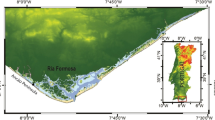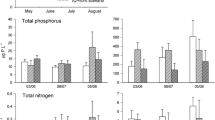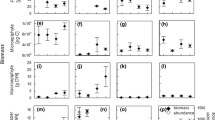Abstract
Aquatic ecosystems face a multitude of environmental stressors, including warming and acidification. While warming is expected to have a pronounced effect on plankton communities, many components of the plankton seem fairly robust towards realistic end-of-century acidification conditions. However, interactions of the two stressors and the inclusion of further factors such as nutrient concentration and trophic interactions are expected to change this outcome. We investigated the effects of warming and high CO2 on a nutrient-deplete late summer plankton community from the Kiel Fjord, Baltic Sea, using a mesocosm setup crossing two temperatures with a gradient of CO2. Phytoplankton and microzooplankton (MZP) growth rates as well as biomass, taxonomic composition, and grazing rates of MZP were analysed. We observed effects of high CO2, warming, and their interactions on all measured parameters. The occurrence and direction of the effects were dependent on the phytoplankton or MZP community composition. In addition, the abundance of small-sized phytoplankton was identified as one of the most important factors in shaping the MZP community composition. Overall, our results indicate that an estuarine MZP community used to strong natural fluctuations in CO2 can still be affected by a moderate increase in CO2 if it occurs in combination with warming and during a nutrient-deplete post-bloom situation. This highlights the importance of including trophic interactions and seasonality aspects when assessing climate change effects on marine zooplankton communities.







Similar content being viewed by others
Data availability statement
The datasets generated and/or analysed during the current study are available in the PANGAEA repository, https://doi.pangaea.de/10.1594/PANGAEA.848402.
References
Aberle N, Lengfellner K, Sommer U (2007) Spring bloom succession, grazing impact and herbivore selectivity of ciliate communities in response to winter warming. Oecologia 150:668–681. https://doi.org/10.1007/s00442-006-0540-y
Aberle N, Schulz KG, Stuhr A, Malzahn AM, Ludwig A, Riebesell U (2013) High tolerance of microzooplankton to ocean acidification in an Arctic coastal plankton community. Biogeosciences 10:1471–1481. https://doi.org/10.5194/bg-10-1471-2013
Alvarez-Fernandez S, Bach LT, Taucher J, Riebesell U, Sommer U, Aberle N, Brussaard CPD, Boersma M (2018) Plankton responses to ocean acidification: the role of nutrient limitation. Prog Oceanogr 165:11–18. https://doi.org/10.1016/j.pocean.2018.04.006
Bach LT, Taucher J, Boxhammer T, Ludwig A, Kristineberg KC, Achterberg EP, Alguero-Muniz M, Anderson LG, Bellworthy J, Budenbender J, Czerny J, Ericson Y, Esposito M, Fischer M, Haunost M, Hellemann D, Horn HG, Hornick T, Meyer J, Sswat M, Zark M, Riebesell U (2016) Influence of ocean acidification on a natural winter-to-summer plankton succession: first insights from a long-term mesocosm study draw attention to periods of low nutrient concentrations. PLoS ONE 11:e0159068. https://doi.org/10.1371/journal.pone.0159068
Berggreen U, Hansen B, Kiorboe T (1988) Food size spectra, ingestion and growth of the copepod Acartia tonsa during development: implications for determination of copepod production. Mar Biol 99:341–352. https://doi.org/10.1007/bf02112126
Boyce DG, Lewis MR, Worm B (2010) Global phytoplankton decline over the past century. Nature 466:591–596. https://doi.org/10.1038/nature09268
Brock TD (1981) Calculating solar radiation for ecological studies. Ecol Model 14:1–19. https://doi.org/10.1016/0304-3800(81)90011-9
Brussaard CPD, Noordeloos AAM, Witte H, Collenteur MCJ, Schulz KG, Ludwig A, Riebesell U (2013) Arctic microbial community dynamics influenced by elevated CO2 levels. Biogeosciences 10:719–731. https://doi.org/10.5194/bg-10-719-2013
Calbet A (2008) The trophic roles of microzooplankton in marine systems. ICES J Mar Sci 65:325–331. https://doi.org/10.1093/icesjms/fsn013
Calbet A, Landry MR (2004) Phytoplankton growth, microzooplankton grazing, and carbon cycling in marine systems. Limnol Oceanogr 49:51–57. https://doi.org/10.4319/lo.2004.49.1.0051
Calbet A, Saiz E (2018) How much is enough for nutrients in microzooplankton dilution grazing experiments? J Plankton Res 40:109–117. https://doi.org/10.1093/plankt/fbx070
Calbet A, Sazhin AF, Nejstgaard JC, Berger SA, Tait ZS, Olmos L, Sousoni D, Isari S, Martinez RA, Bouquet JM, Thompson EM, Bamstedt U, Jakobsen HH (2014) Future climate scenarios for a coastal productive planktonic food web resulting in microplankton phenology changes and decreased trophic transfer efficiency. PLoS ONE 9:e94388. https://doi.org/10.1371/journal.pone.0094388
Carey PG (1992) Marine interstitial ciliates: an illustrated key. Chapman & Hall, London, New York
Christaki U, Dolan JR, Pelegri S, Rassoulzadegan F (1998) Consumption of picoplankton-size particles by marine ciliates: effects of physiological state of the ciliate and particle quality. Limnol Oceanogr 43:458–464. https://doi.org/10.4319/lo.1998.43.3.0458
Collins M, Knutti R, Arblaster J, Dufresne J-L, Fichefet T, Friedlingstein P, Gao X, Gutowski WJ, Johns T, Krinner G, Shongwe M, Tebaldi C, Wehner M (2013) Long-term climate change: projections, commitments and irreversibility. In: Stocker TF, Qin D, Plattner G-K, Tignor M, Allen SK, Boschung J, Nauels A, Xia Y, Bex V, Midgley PM (eds) Climate Change 2013: The physical science basis Contribution of working group I to the fifth assessment report of the Intergovernmental Panel on Climate Change. Cambridge University Press, Cambridge, New York
Durant JM, Hjermann DO, Ottersen G, Stenseth NC (2007) Climate and the match or mismatch between predator requirements and resource availability. Clim Res 33:271–283. https://doi.org/10.3354/cr033271
Feely RA, Alin SR, Newton J, Sabine CL, Warner M, Devol A, Krembs C, Maloy C (2010) The combined effects of ocean acidification, mixing, and respiration on pH and carbonate saturation in an urbanized estuary. Estuar Coast Shelf Sci 88:442–449. https://doi.org/10.1016/j.ecss.2010.05.004
Frost BW (1972) Effects of size and concentration of food particles on feeding behavior of marine planktonic copepod Calanus pacificus. Limnol Oceanogr 17:805–815. https://doi.org/10.4319/lo.1972.17.6.0805
Guillard R, Ryther J (1962) Studies of marine planktonic diatoms. Can J Microbiol 8:229–293
Hansen PJ, Calado AJ (1999) Phagotrophic mechanisms and prey selection in free-living dinoflagellates. J Eukaryot Microbiol 46:382–389. https://doi.org/10.1111/j.1550-7408.1999.tb04617.x
Hillebrand H, Dürselen C-D, Kirschtel D, Pollingher U, Zohary T (1999) Biovolume calculation for pelagic and benthic microalgae. J Phycol 35:403–424. https://doi.org/10.1046/j.1529-8817.1999.3520403.x
Hinga KR (1992) Co-occurrence of dinoflagellate blooms and high pH in marine enclosures. Mar Ecol-Prog Ser 86:181–187. https://doi.org/10.3354/meps086181
Hoegh-Guldberg O, Bruno JF (2010) The impact of climate change on the world's marine ecosystems. Science 328:1523–1528. https://doi.org/10.1126/science.1189930
Horn HG, Boersma M, Garzke J, Löder MGJ, Sommer U, Aberle N (2016a) Effects of high CO2 and warming on a Baltic Sea microzooplankton community. ICES J Mar Sci 73:772–782. https://doi.org/10.1093/icesjms/fsv198
Horn HG, Sander N, Stuhr A, Algueró-Muniz M, Bach LT, Löder MGJ, Boersma M, Riebesell U, Aberle N (2016b) Low CO2 sensitivity of microzooplankton communities in the Gullmar Fjord, Skagerrak: evidence from a long-term mesocosm study. PLoS ONE. https://doi.org/10.1371/journal.pone.0165800
Hothorn T, Zeileis A, Millo G, Mitchell D (2011) Testing linear regression models. https://CRAN.R-project.org/package=lmtest. Accessed 30 July 2019
Irigoien X, Flynn KJ, Harris RP (2005) Phytoplankton blooms: a ‘loophole’ in microzooplankton grazing impact? J Plankton Res 27:313–321. https://doi.org/10.1093/plankt/fbi011
Javidpour J, Molinero JC, Peschutter J, Sommer U (2009) Seasonal changes and population dynamics of the ctenophore Mnemiopsis leidyi after its first year of invasion in the Kiel Fjord, Western Baltic Sea. Biol Invasions 11:873–882. https://doi.org/10.1007/s10530-008-9300-8
Johansson M (2004) Annual variability in ciliate community structure, potential prey and predators in the open northern Baltic Sea proper. J Plankton Res 26:67–80. https://doi.org/10.1093/plankt/fbg115
Jonsson PR, Tiselius P (1990) Feeding behavior, prey detection and capture efficiency of the copepod Acartia tonsa feeding on planktonic ciliates. Mar Ecol-Prog Ser 60:35–44. https://doi.org/10.3354/meps060035
Klein Breteler WCM, Fransz HG, Gonzalez SR (1982) Growth and development of four calanoid copepod species under experimental and natural conditions. Neth J Sea Res 16:195–207. https://doi.org/10.1016/0077-7579(82)90030-8
Kraberg AC, Baumann M, Dürselen C-D (2010) Coastal phytoplankton: photo guide for northern European seas. Pfeil, Munich
Kroeker KJ, Kordas RL, Crim R, Hendriks IE, Ramajo L, Singh GS, Duarte CM, Gattuso JP (2013) Impacts of ocean acidification on marine organisms: quantifying sensitivities and interaction with warming. Glob Change Biol 19:1884–1896. https://doi.org/10.1111/gcb.12179
Landry MR, Hassett RP (1982) Estimating the grazing impact of marine micro-zooplankton. Mar Biol 67:283–288. https://doi.org/10.1007/bf00397668
Lennartz ST, Lehmann A, Herrford J, Malien F, Hansen HP, Biester H, Bange HW (2014) Long-term trends at the Boknis Eck time series station (Baltic Sea), 1957–2013: does climate change counteract the decline in eutrophication? Biogeosciences 11:6323–6339. https://doi.org/10.5194/bg-11-6323-2014
Lewandowska AM, Boyce DG, Hofmann M, Matthiessen B, Sommer U, Worm B (2014) Effects of sea surface warming on marine plankton. Ecol Lett 17:614–623. https://doi.org/10.1111/ele.12265
Lewis E, Wallace DWR (1998) Program developed for CO2 system calculations. ORNL/CDIAC-105. Carbon Dioxide Information Analysis Center, Oak Ridge National Laboratory, U.S. Department of Energy, Oak Ridge, Tennessee
Le Quéré C, Andres RJ, Boden T, Conway T, Houghton RA, House JI, Marland G, Peters GP, van der Werf GR, Ahlström A, Andrew RM, Bopp L, Canadell JG, Ciais P, Doney SC, Enright C, Friedlingstein P, Huntingford C, Jain AK, Jourdain C, Kato E, Keeling RF, Klein Goldewijk K, Levis S, Levy P, Lomas M, Poulter B, Raupach MR, Schwinger J, Sitch S, Stocker BD, Viovy N, Zaehle S, Zeng N (2013) The global carbon budget 1959–2011. Earth Syst Sci Data 5:165–185. https://doi.org/10.5194/essd-5-165-2013
Li QP, Franks PJS, Landry MR (2017) Recovering growth and grazing rates from nonlinear dilution experiments. Limnol Oceanogr 62:1825–1835. https://doi.org/10.1002/lno.10536
Lischka S, Bach LT, Schulz KG, Riebesell U (2017) Ciliate and mesozooplankton community response to increasing CO2 levels in the Baltic Sea: insights from a large-scale mesocosm experiment. Biogeosciences 14:447–466. https://doi.org/10.5194/bg-14-447-2017
Löder MGJ, Meunier C, Wiltshire KH, Boersma M, Aberle N (2011) The role of ciliates, heterotrophic dinoflagellates and copepods in structuring spring plankton communities at Helgoland Roads, North Sea. Mar Biol 158:1551–1580. https://doi.org/10.1007/s00227-011-1670-2
Low-Decarie E, Fussmann GF, Bell G (2014) Aquatic primary production in a high-CO2 world. Trends Ecol Evol 29:223–232. https://doi.org/10.1016/j.tree.2014.02.006
Melzner F, Thomsen J, Koeve W, Oschlies A, Gutowska MA, Bange HW, Hansen HP, Kortzinger A (2013) Future ocean acidification will be amplified by hypoxia in coastal habitats. Mar Biol 160:1875–1888. https://doi.org/10.1007/s00227-012-1954-1
Menden-Deuer S, Lessard EJ (2000) Carbon to volume relationships for dinoflagellates, diatoms, and other protist plankton. Limnol Oceanogr 45:569–579. https://doi.org/10.4319/lo.2000.45.3.0569
Meunier CL, Algueró-Muniz M, Horn HG, Lange JAF, Boersma M (2016) Direct and indirect impact of near-future pCO2 levels on zooplankton dynamics. Mar Freshw Res 68:373–380. https://doi.org/10.1071/MF15296
Montagnes DJS, Strüder-Kype MC, Kype MR, Agatha S, Warwick J (2001) The planktonic ciliate project: the user-friendly guide to coastal planktonic ciliates. https://www.zooplankton.cn/ciliate/. Acessed 01 Apr 2014
Morison F, Menden-Deuer S (2017) Doing more with less? Balancing sampling resolution and effort in measurements of protistan growth and grazing-rates. Limnol Oceanogr- Meth 15:794–809. https://doi.org/10.1002/lom3.10200
Nielsen LT, Jakobsen HH, Hansen PJ (2010) High resilience of two coastal plankton communities to twenty-first century seawater acidification: evidence from microcosm studies. Mar Biol Res 6:542–555. https://doi.org/10.1080/17451000903476941
O'Connor MI, Piehler MF, Leech DM, Anton A, Bruno JF (2009) Warming and resource availability shift food web structure and metabolism. PLoS Biol 7:6. https://doi.org/10.1371/journal.pbio.1000178
Oksanen J, Blanchet FG, Kindt R, Legendre P, Minchin PR, O'Hara RB, Simpson GL, Solymos P, Stevens MHH, Wagner H (2011) Community ecology package. https://CRAN.R-project.org/package=vegan. Accessed 02 Aug 2019
Paul AJ, Bach LT, Schulz KG, Boxhammer T, Czerny J, Achterberg EP, Hellemann D, Trense Y, Nausch M, Sswat M, Riebesell U (2015) Effect of elevated CO2 on organic matter pools and fluxes in a summer Baltic Sea plankton community. Biogeosciences 12:6181–6203. https://doi.org/10.5194/bg-12-6181-2015
Paul C, Sommer U, Garzke J, Moustaka-Gouni M, Paul A, Matthiessen B (2016) Effects of increased CO2 concentration on nutrient limited coastal summer plankton depend on temperature. Limnol Oceanogr 61:853–868. https://doi.org/10.1002/lno.10256
Pinheiro J, Bates D, DebRoy S, Sarkar D, R Core team (2011) Linear and nonlinear mixed effects models. https://CRAN.R-project.org/package=nlme. Accessed 30 July 2019
Pörtner H (2008) Ecosystem effects of ocean acidification in times of ocean warming: a physiologist’s view. Mar Ecol-Prog Ser 373:203–217. https://doi.org/10.3354/meps07768
Putt M, Stoecker DK (1989) An experimentally determined carbon : volume ratio for marine "oligotrichous" ciliates from estuarine and coastal waters. Limnol Oceanogr 34:1097–1103. https://doi.org/10.4319/lo.1989.34.6.1097
R Development Core Team (2011) R: A language and environment for statistical computing. R Foundation for Statistical Computing, Vienna
Riebesell U, Gattuso JP, Thingstad TF, Middelburg JJ (2013) "Arctic ocean acidification: pelagic ecosystem and biogeochemical responses during a mesocosm study" Preface. Biogeosciences 10:5619–5626. https://doi.org/10.5194/bg-10-5619-2013
Rose JM, Caron DA (2007) Does low temperature constrain the growth rates of heterotrophic protists? Evidence and implications for algal blooms in cold waters. Limnol Oceanogr 52:886–895. https://doi.org/10.4319/lo.2007.52.2.0886
Rose JM, Feng Y, Gobler CJ, Gutierrez R, Hare CE, Leblanc K, Hutchins DA (2009) Effects of increased pCO2 and temperature on the North Atlantic spring bloom. II. Microzooplankton abundance and grazing. Mar Ecol-Prog Ser 388:27–40. https://doi.org/10.3354/meps08134
Rossoll D, Sommer U, Winder M (2013) Community interactions dampen acidification effects in a coastal plankton system. Mar Ecol-Prog Ser 486:37–46. https://doi.org/10.3354/meps10352
Rost B, Zondervan I, Wolf-Gladrow D (2008) Sensitivity of phytoplankton to future changes in ocean carbonate chemistry: current knowledge, contradictions and research directions. Mar Ecol-Prog Ser 373:227–237. https://doi.org/10.3354/meps07776
RStudio Team (2011) RStudio: Integrated Development for R. RStudio Inc, Boston
Sabatini M, Kiorboe T (1994) Egg production, growth and development of the cyclopoid copepod Oithona similis. J Plankton Res 16:1329–1351. https://doi.org/10.1093/plankt/16.10.1329
Sabine CL, Feely RA, Gruber N, Key RM, Lee K, Bullister JL, Wanninkhof R, Wong CS, Wallace DWR, Tilbrook B, Millero FJ, Peng TH, Kozyr A, Ono T, Rios AF (2004) The oceanic sink for anthropogenic CO2. Science 305:367–371. https://doi.org/10.1126/science.1097403
Sala MM, Aparicio FL, Balagué V, Bora JA, Borrull E, Cardelús C, Cros L, Gomes A, López-Sanz A, Malits A, Martinez RA, Mestre M, Movilla J, Sarmento H, Vázquez-Domínguez E, Vaqué D, Pinhassi J, Calbet A, Calvo E, Gasol JM, Pelejero C, Marrasé C (2016) Contrasting effects of ocean acidification on the microbial food web under different trophic conditions. ICES J Mar Sci 73:670–679. https://doi.org/10.1093/icesjms/fsv130
Sellner KG (1997) Physiology, ecology, and toxic properties of marine cyanobacteria blooms. Limnol Oceanogr 42:1089–1104. https://doi.org/10.4319/lo.1997.42.5_part_2.1089
Shannon C, Weaver W (1963) The mathematical theory of communication. University of Illinois Press, Urbana
Smetacek V (1985) The annual cycle of Kiel Bight plankton: a long-term analysis. Estuaries 8:145–157. https://doi.org/10.2307/1351864
Sommer U, Aberle N, Engel A, Hansen T, Lengfellner K, Sandow M, Wohlers J, Zollner E, Riebesell U (2007) An indoor mesocosm system to study the effect of climate change on the late winter and spring succession of Baltic Sea phyto- and zooplankton. Oecologia 150:655–667. https://doi.org/10.1007/s00442-006-0539-4
Sommer U, Paul C, Moustaka-Gouni M (2015) Warming and ocean acidification effects on phytoplankton - from species shifts to size shifts within species in a mesocosm experiment. PLoS ONE 10:e0125239. https://doi.org/10.1371/journal.pone.0125239
Stoecker DK, Li AS, Coats DW, Gustafson DE, Nannen MK (1997) Mixotrophy in the dinoflagellate Prorocentrum minimum. Mar Ecol-Prog Ser 152:1–12. https://doi.org/10.3354/meps152001
Suffrian K, Simonelli P, Nejstgaard JC, Putzeys S, Carotenuto Y, Antia AN (2008) Microzooplankton grazing and phytoplankton growth in marine mesocosms with increased CO2 levels. Biogeosciences 5:1145–1156. https://doi.org/10.5194/bg-5-1145-2008
Taucher J, Bach LT, Boxhammer T, Nauendorf A, TGCKC, Achterberg EP, Algueró-Muñiz M, Arístegui J, Czerny J, Esposito M, Guan W, Haunost M, Horn HG, Ludwig A, Meyer J, Spisla C, Sswat M, Stange P, Riebesell U, Aberle-Malzahn N, Archer S, Boersma M, Broda N, Büdenbender J, Clemmesen C, Deckelnick M, Dittmar T, Dolores-Gelado M, Dörner I, Fernández-Urruzola I, Fiedler M, Fischer M, Fritsche P, Gomez M, Grossart H-P, Hattich G, Hernández-Brito J, Hernández-Hernández N, Hernández-León S, Hornick T, Kolzenburg R, Krebs L, Kreuzburg M, Lange JAF, Lischka S, Linsenbarth S, Löscher C, Martínez I, Montoto T, Nachtigall K, Osma-Prado N, Packard T, Pansch C, Posman K, Ramírez-Bordón B, Romero-Kutzner V, Rummel C, Salta M, Martínez-Sánchez I, Schröder H, Sett S, Singh A, Suffrian K, Tames-Espinosa M, Voss M, Walter E, Wannicke N, Xu J, Zark M (2017) Influence of ocean acidification and deep water upwelling on oligotrophic plankton communities in the subtropical North Atlantic: insights from an in situ mesocosm study. Front Mar Sci. https://doi.org/10.3389/fmars.2017.00085
Thackeray SJ, Sparks TH, Frederiksen M, Burthe S, Bacon PJ, Bell JR, Botham MS, Brereton TM, Bright PW, Carvalho L, Clutton-Brock T, Dawson A, Edwards M, Elliott JM, Harrington R, Johns D, Jones ID, Jones JT, Leech DI, Roy DB, Scott WA, Smith M, Smithers RJ, Winfield IJ, Wanless S (2010) Trophic level asynchrony in rates of phenological change for marine, freshwater and terrestrial environments. Glob Change Biol 16:3304–3313. https://doi.org/10.1111/j.1365-2486.2010.02165.x
Thomsen J, Gutowska MA, Saphorster J, Heinemann A, Trubenbach K, Fietzke J, Hiebenthal C, Eisenhauer A, Kortzinger A, Wahl M, Melzner F (2010) Calcifying invertebrates succeed in a naturally CO2-rich coastal habitat but are threatened by high levels of future acidification. Biogeosciences 7:3879–3891. https://doi.org/10.5194/bg-7-3879-2010
Thor P, Nielsen TG, Tiselius P, Juul-Pedersen T, Michel C, Moller EF, Dahl K, Selander E, Gooding S (2005) Post-spring bloom community structure of pelagic copepods in the Disko Bay, Western Greenland. J Plankton Res 27:341–356. https://doi.org/10.1093/plankt/fbi010
Utermöhl H (1958) Methods of collecting plankton for various purposes are discussed. SIL Commun 1953–1996(9):1–38. https://doi.org/10.1080/05384680.1958.11904091
Weisse T, Karstens N, Meyer VCL, Janke L, Lettner S, Teichgraber K (2001) Niche separation in common prostome freshwater ciliates: the effect of food and temperature. Aquat Microb Ecol 26:167–179. https://doi.org/10.3354/ame026167
Acknowledgements
This study is part of the “Verbundprojekt” BIOACID phase II, consortium 1, WP 1.6 (03F0655B) funded by the German Federal Ministry of Education and Science (BMBF). We thank the BIOACID Indoor Mesocosm team for their help with maintenance and sampling of the mesocosms, especially C. Paul, A. Paul, and M. Rönspies. T. Hansen, B. Gardeler, and K. Carstens are additionally acknowledged for their technical assistance. We also thank S. Alvarez-Fernandez for his help with data analysis and two anonymous reviewers for their valuable comments on an earlier version of this manuscript.
Author information
Authors and Affiliations
Corresponding author
Ethics declarations
Conflict of interest
The authors declare that they have no conflicts of interest. Funding was provided by the German Federal Ministry of Education and Science (BMBF).
Ethical approval
All applicable national and/or institutional guidelines for sampling and experimental use of organisms for the study have been followed.
Additional information
Responsible Editor: O. Vadstein.
Publisher's Note
Springer Nature remains neutral with regard to jurisdictional claims in published maps and institutional affiliations.
Reviewed by: B. Love and an undisclosed expert.
Electronic supplementary material
Below is the link to the electronic supplementary material.
Rights and permissions
About this article
Cite this article
Horn, H.G., Boersma, M., Garzke, J. et al. High CO2 and warming affect microzooplankton food web dynamics in a Baltic Sea summer plankton community. Mar Biol 167, 69 (2020). https://doi.org/10.1007/s00227-020-03683-0
Received:
Accepted:
Published:
DOI: https://doi.org/10.1007/s00227-020-03683-0




